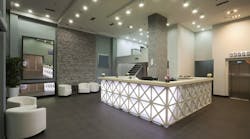A lot goes into planning a lighting retrofit, and if it’s your first time undertaking the project, it can be hard to know where to start. Knowing the right priorities to focus on, people to work with and solutions can help make the project a success.
Modern interior of a hotel lobby. | Photo: krsmanovic
When beginning a lighting retrofit, you need to know your goals and requirements of the project, says Frank Agraz, Business Development Manager at OSRAM SYLVANIA. Common goals and requirements include cost restraints, energy savings and lighting requirements.
Determine Lighting Retrofit Project Goals
“People need to understand the corporate goals, at both the local and office level, of who the audience is and the expectations of the retrofit,” Agraz says. If the goals of corporate and the needs of the retrofit don’t line up, challenge them.
Read also: Aging Lighting – Replace or Retrofit?
“Are the right metrics being evaluated?” he asks. “Include total cost of ownership if that’s needed to show value and wasn’t being included.”
Consider who’s evaluating the bids. Is someone from procurement who doesn’t know about lighting deciding what retrofit to use? Or is someone with industry knowledge making the final decision? The final decision maker should understand the total cost of ownership and what goes into lighting.
Exterior of an office building | Photo: Dima Moroz
It’s important to understand the cost of waiting, Agraz stresses. If getting the bids and deciding who to use and when to start takes several months, that’s several months of energy savings that’s being lost. Going with a lighting partner that could have moved the project along sooner might be more cost-efficient in the long run.
Partner with a Lighting Practitioner
Once you have figured out your goals and requirements, choose a lighting partner that maximizes your goals.
On topic: Set Up Your Building Management System for Energy Conservation Success
“Find a lighting practitioner who knows the whole industry and solution, not just certain brands,” Agraz encourages. Be sure they help you get the result that’s right for you and aren’t receiving an incentive to do a project that fits their goals and needs.
When searching for a lighting partner, look for someone with credentials that show they are an expert who has passed an exam and has continuing education. Examples of lighting credentials include LC, CLMC, NCQLPO and NALMCO.
There are three main lighting retrofit options – luminaires, kits and TLEDs. Of those, “you need to define what’s the ‘best’ or ‘right’ solution for you,” Agraz says, noting there are benefits and drawbacks to each option.
Luminaires
- New fixture or redesign
- Existing system is in poor condition
- Optics and thermal management are critical
Kits
- Reuse the housing already there
- Minimum disruption
- Balance of cost and performance
- Existing luminaire is in good condition and location
TLED (tubular LED)
- Lowest first cost
- Lowest total cost of ownership isn’t a priority
Once you’ve narrowed down the type of lighting retrofit, you can look at specific lighting products. When looking at a manufacturer’s product to determine if it’s right for your project, consider its:
- History
- Capabilities
- Recalls
- Failure rates
- Lessons learned
- Warranties
- Support
Don’t overlook the potential hidden costs and value, including incentives, waste removal and rebates.
Modern office interior | Photo: Zhu Difeng
Evaluate whether you have the right amount and solution in a given space, and ensure it’s maximized for efficiency. This could mean reducing the lighting load with a higher efficacy solution or the amount a light is on or dimmed, as well as designing solutions for the appropriate level so as not to overlight a space.
Find the 10 Money-Saving Lighting Products for 2018
For more information on undergoing a lighting retrofit, Agraz suggests the Illuminating Engineering Society for information including lighting handbooks, design and practical information.
Valerie Dennis Craven [email protected] is editor-in-chief for BUILDINGS.
Two hand-picked articles to read next:



